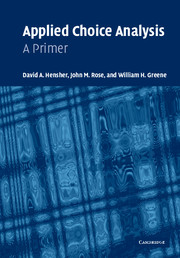Book contents
- Frontmatter
- Contents
- List of figures
- List of tables
- Preface
- Part I Basic topics
- 1 In the beginning
- 2 Basic notions of statistics
- 3 Choosing
- 4 Paradigms of choice data
- 5 Processes in setting up stated choice experiments
- 6 Choices in data collection
- 7 NLOGIT for applied choice analysis: a primer
- 8 Handling choice data
- 9 Case study: mode-choice data
- 10 Getting started modeling: the basic MNL model
- 11 Getting more from your model
- 12 Practical issues in the application of choice models
- Part II Advanced topics
- Glossary
- References
- Index
5 - Processes in setting up stated choice experiments
Published online by Cambridge University Press: 05 September 2012
- Frontmatter
- Contents
- List of figures
- List of tables
- Preface
- Part I Basic topics
- 1 In the beginning
- 2 Basic notions of statistics
- 3 Choosing
- 4 Paradigms of choice data
- 5 Processes in setting up stated choice experiments
- 6 Choices in data collection
- 7 NLOGIT for applied choice analysis: a primer
- 8 Handling choice data
- 9 Case study: mode-choice data
- 10 Getting started modeling: the basic MNL model
- 11 Getting more from your model
- 12 Practical issues in the application of choice models
- Part II Advanced topics
- Glossary
- References
- Index
Summary
As far as the laws of mathematics refer to reality, they are not certain, and as far as they are certain, they do not refer to reality.
(Albert Einstein, 1879–1955)Introduction
We focus in this chapter on explaining the processes used in generating an experimental design, although we warn that the reader will not become an expert after having completed this chapter. Like choice modeling, experimental design is very much owned by the specialist. We have decided to concentrate on the practical aspect of experimental design, as conversations with both colleagues and students over many years have confirmed that it is perhaps this topic which is the least understood subject matter related to choice modeling. We refer those readers interested in the theoretical aspects of experimental design to other texts such as Louviere, Hensher, and Swait (2000) which provide a more detailed treatment of the topic.
If at the end of this chapter the reader can understand the jargon used in the experimental design literature and generate simple experimental designs then we will be satisfied that we have achieved our aim.
What is an experimental design?
The foundation for any SP experiment is an experimental design. An experiment defined in scientific terms involves the observation of the effect upon one variable, a response variable, given the manipulation of the levels of one or more other variables. The manipulation of the levels of the variables does not occur in a haphazard manner. Rather we turn to a specialized form of statistics to determine what manipulations to make and when to make them. Thus we can say that the manipulations occur by design.
- Type
- Chapter
- Information
- Applied Choice AnalysisA Primer, pp. 100 - 160Publisher: Cambridge University PressPrint publication year: 2005
- 1
- Cited by



